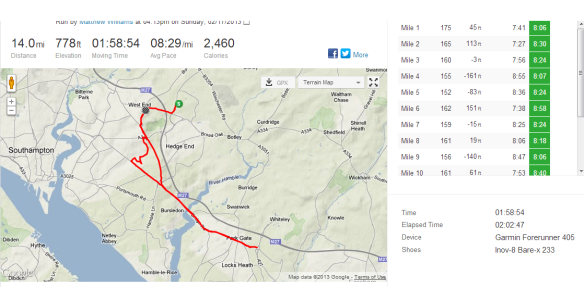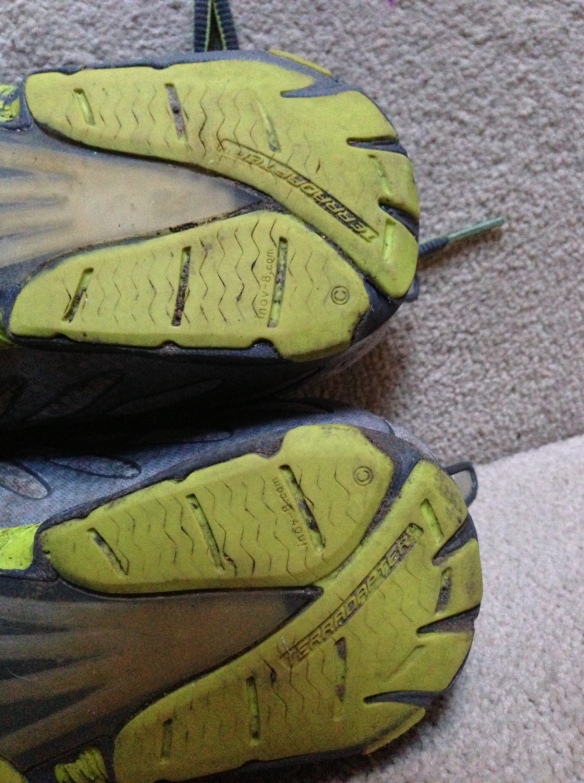I mentioned on a previous post that I bought a pair of Vibram Bikila toe-shoes and then shortly after read the excellent “Born to Run” book by Christoper Mcdougall. Interestingly, I realised that I had done it the unusual way round of shoes first, book second. Most people read the book, get inspired and decide to run more ‘naturally’ and go out and buy a pair of ‘barefoot’ trainers (there’s an oxymoron for you), with the goal of running as close to barefoot as possible. In my case, Becca and I had already been recommended the toe-shoes by my brother-in-law as a way of running differently and potentially injury-free. It was once I’d tried the shoes that I went and did some further research, which is where the book came in.
I won’t wax lyrical about the book, that’s been done enough on many blogs and websites in the past. If you haven’t already read it and have a passing interest in running, please go read it. Sadly, I bought it on the Kindle so don’t have a copy of the book to pass around to my friends. Some people say it’s propaganda for the minimalist/barefoot running movement, and in some ways it is. What it has definitely done though is inspired a movement towards people taking time to consider what they put on their feet.
I have a pair of Nike Zoom Equalon 4 running shoes I bought after putting them on in a shoe-store, walking up and down the aisles a bit, bouncing up and down a little and feeling the lovely springy cushioning in them and thinking that the feeling of walking on clouds was what running shoes were all about. Admittedly not the most thorough way of testing.

My ‘old’ running shoes.
On reading the book, and then doing further research I realised that big, cushioned shoes are not the way forward. Running shoe manufacturers know exactly what they’re doing making shoes feel like they’re made of marsh-mellow when you test them on in a store. They want people to buy more shoes after doing the briefest of tests, as I did, and it works.What the extra cushioning does do is make it possible for people to run by landing on their heel first, and this, it seems, is not a natural way of running. To test this out, watch children running around before they get to wearing shoes, they’ll land on the front of their foot before letting their heel land. Watch the fastest human being ever to walk the planet, Usain Bolt, and other sprinters, their heels barely even touch the floor. Test it out yourself, take your shoes off and run just 10 yards (do it somewhere safe), you will naturally and instinctively run on the balls of your feet.

The above graph is from a
Harvard study on the bio-mechanical differences between the different types of foot strike. The comparative graph for a runner landing on the the front of their foot or mid-foot is a much smoother single curve and a more balanced load of the body weight along the duration of the running stride. The impact of this continuously over the average 150-180 strides per minute can add up and make a runner more prone to injury. The other key factor of heel striking is that the point of impact tends to be further ahead of the body (shown below) meaning the impact force is actually pushing back against the direction of movement.

I could go into more detail, but the study above gives the information more accurately than I ever could, and sites such as the
Barefoot Running University also give some fantastic insight if you’re after more. The end result of me doing my research was that I was firmly convinced that running naturally and focusing on a forefoot strike was the way forward for me. Having been running now for over half a year, I believe I have transitioned well to a mid-foot strike rather than heel or forefoot. It may be that over time I transition even further forward, but the mid-foot strike, with my feet landing underneath my body mass as I run is really working for me. My calf injury of last year from trying too much too soon has gone completely, and I feel happy running and am getting quicker, even over distances approaching 10miles
As much as I’d love the idea of running entirely barefoot and feeling every step I run, the streets and climate of Southampton and the UK in general are not conducive to going all-in for the barefoot movement. Against my wife and my bank accounts’ better judgement, I have already tested out a few different types of running shoe to try and work out what feels best for me and settled on a minimalist-with-some-cushioning end of the spectrum rather than trying to get as close to barefoot as possible. I’ll discuss my shoe collection in a later post I’m sure.The four things I feel are important in a running shoe are the following:
- Level or minimal heel-toe drop, meaning that any cushioning/sole below the foot should be as close to the same width as possible the whole way along the shoe. A raised, excessively cushioned heel is not an option as this gets in the way of a natural midfoot landing.
- Flexibility along the sole (or last) in all directions. My foot bends naturally in multiple directions and so should my shoe.
- The sole shouldn’t be overly soft or overly thick for two reasons. Firstly, more cushioning simply weighs more, and it’s easier to run with less weight on the feet. Secondly cushioning makes it hard to feel and respond to the floor, what is known as ‘proprioception’ or ground feel. If you can feel what is under your feet better, you can respond quickly to unexpected changes in the surface you’re running on.
- Wide toe box. I don’t know about you, but my foot naturally is not the shape of the end of a pair of shoes, I like walking around the house barefoot and my toes naturally splay out to support my body weight. I want to be able to do that in my running shoes too, for stability and responsiveness.

Top two pictures are of a person who has never worn shoes. The bottom two are of a person who has.
The above picture speaks volumes for the effect of tight fitting or shaped shoes. I plan for the rest of my life to remember that image when buying shoes for any type of activity, not just running. My goal is to run as close to naturally as possible and run as far as possible, this may require some padding below my feet as I adjust to first running for 26.2miles and then further. The thing that sticks in my mind the most came from my older brother when I first spoke about the toe-shoes and why they make sense his response was “You mean, God designed us right in the first place?”.
 As you can see from the run above, I set out to do a 7mile there-and-back route for my long run, which was mistake number 1. Actually, it wouldn’t have been a mistake other than it was compounded by the idea that I wanted to do it with some effort this week. On Saturday, my friend Gary, who I’m running the marathon with did his long run of 12miles at 8:30min/miles. Gary is the one who first bullied me into signing up for the marathon, or to be precise, he twisted my arm gently and I agreed pretty quickly. This inspired me to want to go out and see if I could do the same. Sadly, I forgot Gary lives on the sea front, so did a 12mile run with around 280ft of elevation total throughout. The route I picked, had 3 times as much total elevation, including some pretty long steady climbs, and a couple of very short but very steep routes. Oh, and I also got lost on the way back, which is why there’s a weird loop on the map rather than a nice line going straight out and straight back.
As you can see from the run above, I set out to do a 7mile there-and-back route for my long run, which was mistake number 1. Actually, it wouldn’t have been a mistake other than it was compounded by the idea that I wanted to do it with some effort this week. On Saturday, my friend Gary, who I’m running the marathon with did his long run of 12miles at 8:30min/miles. Gary is the one who first bullied me into signing up for the marathon, or to be precise, he twisted my arm gently and I agreed pretty quickly. This inspired me to want to go out and see if I could do the same. Sadly, I forgot Gary lives on the sea front, so did a 12mile run with around 280ft of elevation total throughout. The route I picked, had 3 times as much total elevation, including some pretty long steady climbs, and a couple of very short but very steep routes. Oh, and I also got lost on the way back, which is why there’s a weird loop on the map rather than a nice line going straight out and straight back.





